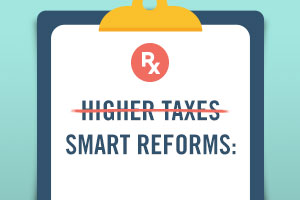Memo

Ten Facts About the Shadow Budget
Four tax hikes in eight years have failed to solve Pennsylvania’s budget challenges or grow the economy. In contrast, utilizing unused reserve funds in the shadow budget can responsibly balance this year's budget without increasing burdens on families or job creators.
1. Pennsylvania’s shadow budget includes more than 150 special funds and accounts for about 60 percent of state government's cost.
These state funds currently have a surplus of $9.4 billion in their checking and savings accounts.* Lawmakers should utilize these unreasonable surpluses to balance the budget—paying off last year’s budget deficit—before raising taxes on working families.
2. Drawing down on the state’s fund balances is an appropriate one-time solution for the one-time problem of $1.5 billion in unpaid bills from last fiscal year.
The one-time proposed $1.2 billion transfer represents just 13 percent of the balance sitting in the Treasury’s investment pools.
The state should not rely on fund transfers to pay for current and future spending. That’s why rank and file house lawmakers have also proposed reducing corporate welfare tax credits by 50 percent and permanently redirecting $100 million in tax revenue from the shadow budget to the General Fund.
3. Utilizing excessive fund balances is not a form of borrowing.
Transferring a portion of ongoing surplus funds from the shadow budget would not require interest payments, and lawmakers do not need to replenish these fund balances. The only plan that requires interest payments is the proposal passed by the state senate to borrow up to $1.3 billion from future Tobacco Settlement Fund revenue—which would require about $2.1 billion in repayment over 30 years, and $75 million in costs for bond lawyers.
4. Many of the shadow budget funds are paid for with tax dollars, not user fees or premium payments.
For example, the Public Transportation Trust Fund is funded partly by turnpike tolls (charged to drivers who choose not to use mass transit). And the Keystone Park, Recreation and Conservation Fund is financed by the Realty Transfer Tax.
5. This is not the first-time lawmakers have tapped the shadow budget.
It is not unusual for lawmakers to redirect funds from the shadow budget to the General Fund. In fiscal year 2015-16, the Pennsylvania Economic Revitalization Fund transferred $2.8 million into the General Fund. Last year, a total of $18 million was transferred from the Recycling Fund and the Volunteer Companies Loan Fund to the General Fund. Finally, Pennsylvania Liquor Control Board transfers take place every year.
6. Shining a light on the shadow budget creates transparency.
Few taxpayers are aware of the shadow budget in Pennsylvania. Before lawmakers default to another tax increase, taxpayers should understand what these special funds do and how they can be used to create a balanced budget that works for all Pennsylvanians.
7. There is no evidence operations will be harmed by shifting excess reserves.
Funds in these reserve accounts have been sitting for years, even growing in some cases apart from annual spending. The transfers proposed in the latest proposal were vetted by legal experts to ensure operations would not be affected. Thus far, no agency has been able produce documentation showing the timetable for projects will be negatively impacted. Furthermore, one-time project delays are far preferable to a long-term tax hike on Pennsylvania families.
8. There is no evidence that shifting excess reserves from the Public Transportation Trust Fund reserve will negatively affect SEPTA.
Per the Governor's Executive Budget, the Public Transportation Trust Fund will receive $1.343 billion (from sales taxes, turnpike payments, Lottery Fund transfers, motor vehicle fees and code fines, and transfers from the Public Transportation Assistance Fund) and distribute $1.349 billion during 2017-18.
The Public Transportation Trust Fund had $478 million in reserves as of July 1, up from $212 million in July of 2014. In other words, reserve funds have not been needed to pay mass transit bills in the past three fiscal years. The latest revenue proposal shifts $357 million in reserves to the General Fund, leaving $121 million in reserves.
9. There is no evidence that shifting excess reserves from the Environmental Stewardship fund will cut environmental protection programs.
Per the Governor's Executive Budget, the Environmental Stewardship Fund will receive $125 million (from licenses and fees, transfers from the Marcellus Legacy Fund and the Pennsylvania Economic Revitalization Fund, and interest) and distribute almost $125 million during 2017-18.
The Environmental Stewardship Fund had $104 million in reserves as of July 1, up from $69 million in July of 2014. The latest revenue proposal shifts $72 million in reserves to the General Fund.
10. Shadow budget reforms along with liquor privatization, welfare reform, and corporate welfare reductions can balance the budget.
Tapping shadow budget funds alone would bring $1.2 billion; liquor privatization efforts would bring in an additional $1 million to $329 million. These steps, combined with reducing $800 million in corporate welfare, and other one-time sources highlighted in the house proposal, show there are many ways to balance the budget without tax hikes.
*Note: The balance of the Common Investment Pool fluctuates. The Treasurer’s transparency portal posts the daily balance.